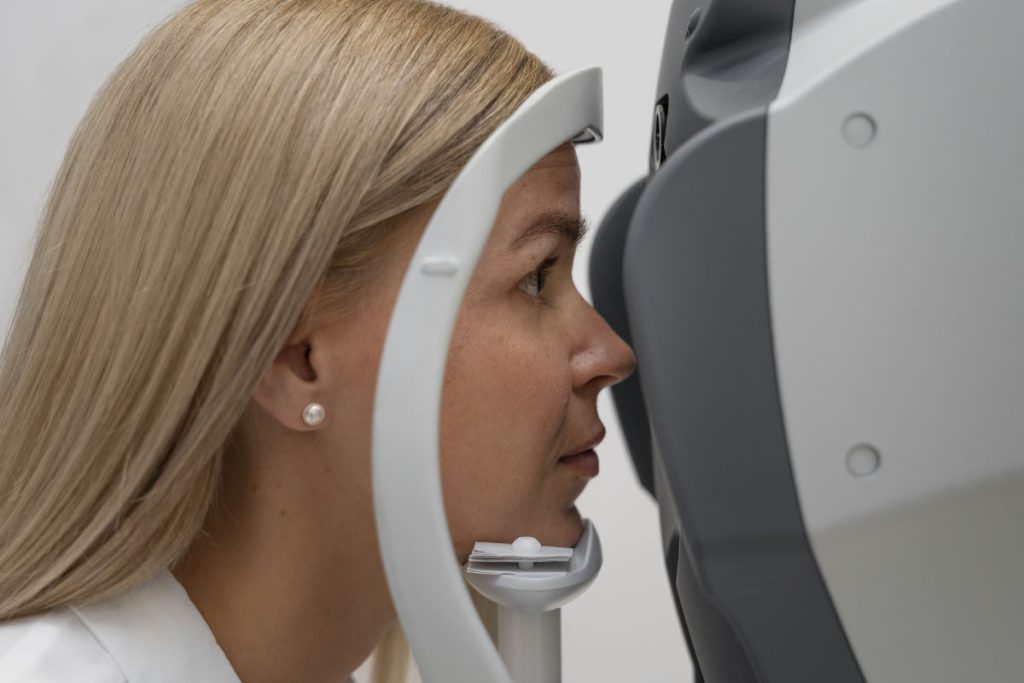
What is the visual field?
The visual field is essentially the area of space that can you can see at the same time. In other words, it refers to your field of vision or how far out peripherally you are able to see without moving your eyes or head.
Generally speaking, if light that is reflected or emitted from an object in your surroundings falls onto your retina, then that object will be visible in your visual field.
This is one of the ways that visual function is measured. Other ways of testing visual function include visual acuity, color vision and contrast sensitivity.
Can you preserve and protect your visual field?
We want to retain our visual field so that we can notice cars coming from the side when crossing the road. We want to be aware of what is around us so we don’t bump into things.
The best way to preserve and protect visual field is through protection of the optic nerve (neuroprotection) and retina (retinoprotection).
This can be achieved through taking vision specific nutrients, and my admitted biased top pick is Nutravision.
Powered by the revolutionary Nutravision technology to deliver unprecedented results, Nutravision is the first formula to tackle all nine biocellular mechanisms of eye ageing that increase the risk of visual field loss from glaucoma (and macular degeneration).
With Nutravision, you are not just taking another vision supplement; you are taking just about the most potent, synergistic and complete vision formula to preserve, safeguard and potentially even enhance your visual field.
This leads to the next question: What exactly is a normal visual field?
Your field of vision can be measured in terms of degrees from the center.
With a healthy and normal eye, you should be able to see approximately 95 degrees temporally (towards your ear) and approximately 60 degrees nasally (towards your nose) from the center.
You should also be able to see 60 degrees above and 75 degrees below from the center.
This means each eye gives you a horizontal field range of 155 degrees and vertical field range of 135 degrees at a given time.
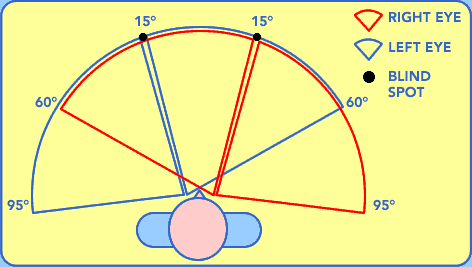
The diagram above depicts the normal horizontal field of vision, including the location of the blind spots for both eyes. In a normal person, the field of vision should span a total width of 190 degrees.
The macula, which is the central part of the retina (and is therefore important for central vision), corresponds to the central 12 to 13 degrees of your visual field.
The center of the macula, called the fovea, has the highest concentration of cone photoreceptors and corresponds to the central 3 degrees of your field of vision.
The optic nerve has no photoreceptor cells. Therefore, light that falls on the optic nerve head (where the optic nerve is attached to the eye) will not be detected. This is why you get a blind spot in your field of vision. The blind spot is approximately 15 degrees towards your ear (temporally) from the center.
The International Council of Ophthalmology has suggested the following driving field requirements, which have been adopted by the Driver and Vehicle Licensing Agency (DVLA) in the United Kingdom:
– 120 degrees of horizontal field
– 40 degrees of vertical field
In the United States, the driving field requirements vary from state to state.
Click here to download the US state vision requirements for driving
How is my visual field tested?
Perimetry is the process of testing your field of vision. There are 2 main types of perimetry: static and kinetic.
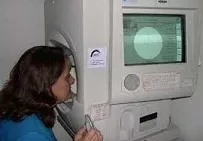
Static perimetry is the most commonly performed method in clinics and hospitals. You will be asked to look at the center of an illuminated white screen with one eye (the other eye is covered). Light spots of different brightness levels will flash on the white screen. Your task is to press a button every time you see a light spot.
If you have or are suspected of having glaucoma, you will need to undergo static perimetry. It is one of the most important tools in glaucoma monitoring. The most popular automated static perimetry machines are the Humphrey, Octopus and Medmont perimeters. Unfortunately, the results are not interchangeable between machines.
Static perimetry usually tests only the central 30 or 24 degrees, and this takes approximately 4 to 7 minutes for each eye. Full field of vision tests can also be performed, but they will be time consuming.
Newer automated perimetry machines have faster algorithms (such as SITA-Faster) that take at most 3 minutes to complete per eye. Most of my patients prefer the faster tests.
Home-based visual field testing (with either a tablet or home computer) is currently being developed. The results are so far comparable with the standard static perimetry machines.
This is very exciting because when fully adopted, you and I no longer need to go to the ophthalmologist or optometrist for a field test. We can simply do the test at home, and the results will be automatically sent to our eye care specialist. The test results are also saved in a cloud server, which allows them to be retrieved at any time.
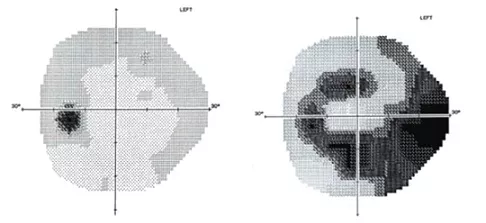
Left: a normal visual field as seen from a healthy left eye
Right: glaucoma causing a reduction in the field, as indicated by the black patches
In kinetic perimetry points of light are moved inwards slowly one by one until you see them. The location where you see the points of light are marked on a piece of paper. The brightness and size of the point of light can be changed. So the larger and brighter the point of light, the easier it should be seen. Kinetic perimetry is not automated. As such, the accuracy of the kinetic perimeter (right) depends a lot on the person operating it.
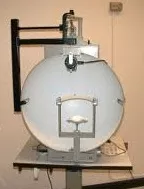
Kinetic perimetry is generally used for mapping out neurological field defects rather than for monitoring glaucoma. So for instance, you may have to undergo kinetic perimetry if you have optic neuritis or a stroke.

Left: Goldmann field of a normal right eye. The red dot signifies the blind spot.
Right: Goldmann field showing a homonymous hemianopia. This person is only able to see the right side of his or her field. This is due to a problem on the right side of the visual cortex of the brain (such as in a stroke), causing the inability to see to the left.
Finally, confrontation is a simple method of clinically evaluating the field of vision. It does not require any instruments and is easy to do.
However, this technique is only useful for detecting gross field defects, such as those that may occur in retinal detachment, ischemic optic neuropathy and stroke. Field testing with confrontation lacks the accuracy to map out small field defects.
With confrontation testing, your visual field is directly being compared with that of your ophthalmologist’s (whose field of vision should be normal, of course). This is done either with fingers, or with white or red hat pins.
I can’t understand my visual field test result. How do I know my visual field has not worsened?
On most static perimetry machines, the field test result includes a Visual Field Index (VFI) score. The VFI ranges from 0% (completely blind) to 100% (full field). I would generally consider that the visual field is normal if your VFI is 95% or more.
Once you reach a VFI of 50%, you have lost half of your visual field and you will start to notice difficulties with your vision. At this stage, driving becomes difficult and you may have to give up driving if both eyes are affected.
With glaucoma, the key is how quickly your visual field deteriorates. Ideally, for my patients I do not want deterioration of more than 1% per year. A rate of less than 1% annually means that you should be able to maintain useful vision for the rest of your life.
The best way to reduce your risk of glaucoma blindness is to make sure you take the treatments as prescribed by your eye specialist. For some patients, I have recommended certain supplements to naturally augment the optic nerve and to complement their glaucoma therapy.
Two that I previously often recommended are ginkgo biloba and vitamin B3 (nicotinamide).
But nowadays (as of May 2023), I just recommend to my patients to take Nutravision, which in my opinion is the most advanced neuroprotection and retinoprotection supplement currently available globally to preserve visual field against glaucoma and macular degeneration damage.
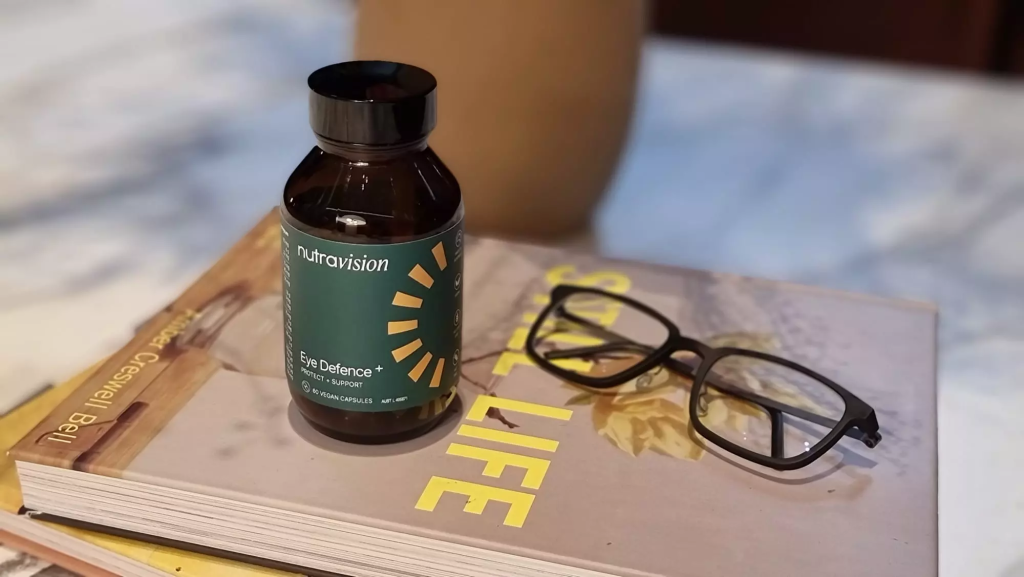
If you are considering any natural treatments for your glaucoma or macular degeneration, please make sure to discuss with your eye specialist and family doctor first to avoid adverse drug interactions and unwanted side effects.


